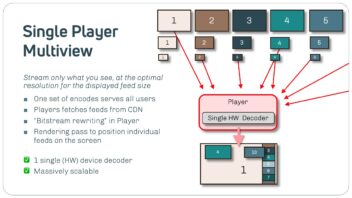Diagnosing Ad Nauseam
Hate it or love it, ads are becoming a big ingredient in our streaming diet.
Like an unexpected spice in your favourite dish, ads can either enhance or spoil the experience. In this part, we dive into the challenges of today’s ad delivery, the technological twists that complicate it, and how outdated methods still dominate the landscape. But stay tuned, part two reveals how we’re changing the game with a smarter, more seamless way to deliver ads, right from the video player itself.
A shaky new normal
The 2020s are set to redefine how people consume entertainment. Cable-cutting and the global rise of diverse OTT and CTV services across the world will drive the majority of consumers away from linear broadcasting into streaming. This also has a major impact on advertising and monetization. Most of today’s streaming platforms for Sports and Entertainment offer an ad-supported tier, with a sub-section of these also offering an ad-free subscription tier. For CTV, more and more content owners now offer FAST (Free Ad-Supported Television), which is the fastest growing segment of CTV consumption. Of course, the mix between ad-based and subscription-based services varies across regions and content libraries, but the general direction of the industry is moving towards ad-based services, illustrated by numbers provided by industry leaders like Netflix, Amazon, Disney and Peacock.

The trend towards ad-based streaming is driven by factors such as Search and Social, Fragmentation, Programmatic ad buys, and contextual advertising. Compared to linear, CTV and OTT advertising can be significantly more targeted, using information like zip codes, the device in use, and certain demographic characteristics of each viewer. This increases the chance of serving relevant ads to the right target audience on the most suitable device. CTV and OTT services are popular amongst younger consumers, meaning that linear services are dealing with a rapidly ageing audience, which makes advertising on CTV and OTT more appealing to advertisers.
Yes, more OTT and CTV consumers are watching ad-based content, but they are still fickle, they often check out or quit the stream if the ad is either irrelevant or served poorly. Even with the more granular information considered, targeting specific ads is still a business in development.
Ads have come a long way, but…
With the increasing audience and more targeted ad-serving possibilities in mind, streaming services and ad-tech companies have iterated the ad insertion workflow for over a decade. These iterations are reflected in multiple ways, both visible to the viewer and in the backend systems. Take the format of advertisements, most of them started as static images, but animated ads are increasing in share. The traditional ad would fully fill up the screen, and these ads would be inserted pre-roll, mid-roll or post roll. Other forms have also been introduced since then, namely ad windows, L shaped ads, and ad banners on one side of the screen.

Ads have also made their way into home screens of streaming services, pause screens during streams, or other (less prominent) positions within the content that is being streamed. Lastly, interactivity is becoming more important to advertisers, as they try to take away barriers for consumers to engage with them instantly. Examples of this are ads with QR codes that take you right to a web shop, or clickable ads that send text messages or E-mails to interested viewers.
Yes, many systems and software products have streamlined the ad insertion workflow, but streaming services often do not focus on the client-side video player stack when it comes to serving effective ads. Most streaming services currently use a form of server-side ad insertion, client-side ad insertion is less common. The impact of ad insertion issues mainly manifests in three ways: QoE, device & platform support, and data analytics.
…be Advised against these issues
Error rates and rebuffering rates are considered high impact, especially at the precarious moment when an advertisement starts or ends. If a viewer is about to rejoin the program after watching an ad to find a buffering spinner, their patience is seriously tested, perhaps even more so than when buffering occurs randomly. Other often-seen problems when ads are inserted include time jumps, and stream crashes. Some of these errors and buffering instances are caused by the ad server on the backend, but many issues can be traced back to the client-side video player stack.
Another challenge for advertisers is covering all relevant platforms and devices. Ads for certain products might make more sense on one set of devices compared to another, and the content of a specific ad might work better on a specific screen size. This can easily lead to issues for streaming platforms that operate on various device sets. When advertisers want to ensure smooth ad insertion across all devices, a lot of testing and iterating must happen before the ad serving mechanism is stable. Resource-limited companies could very well struggle with finding enough capable testers for all devices.
 In addition, ad-related upgrades and bug fixes can take a long time to roll out because of the different code stacks on each of those device sets. Focusing on the client-side video player for streaming services, most code stacks consist of open-source code with a wrapper built around it. With this setup, any cross-platform change can create a host of different problems on each device, leaving streaming services reluctant to touch the ad-serving mechanism, and ultimately hampering efficiency and innovation.
In addition, ad-related upgrades and bug fixes can take a long time to roll out because of the different code stacks on each of those device sets. Focusing on the client-side video player for streaming services, most code stacks consist of open-source code with a wrapper built around it. With this setup, any cross-platform change can create a host of different problems on each device, leaving streaming services reluctant to touch the ad-serving mechanism, and ultimately hampering efficiency and innovation.
The third important aspect is the data analytics of the ad-insertion operation. With CTV and OTT there are more data points available compared to linear broadcast, but this also increases the risk of inaccurate numbers spoiling the overall data, causing streaming services to draw the wrong conclusions after implementing ad campaigns. Data analytics software has improved a lot over the years, but this data still must be gathered on the client-side. If the data collection mechanism within the application is flawed, even the most advanced backend sysems won’t be able to prove their worth. This risk is especially high if this data is collected from different devices (e.g. TVs, phones, STBs, tablets, PCs).
So, what’s the fix for these client-side ad headaches?
It starts with rethinking the role of the video player – not as an afterthought, but as the central point of control for ad delivery. At Tiledmedia, we’ve built a Player that doesn’t just play video – it powers a new generation of ad experiences. Supporting both server-side and client-side insertion, it opens the door to dynamic, context-aware formats that are seamless, engaging, and built for today’s fragmented ecosystem. Next week, we’ll show you exactly how we do it, and why it works. In the meantime, we’d love to hear from you – reach out at [email protected].
June 23, 2025
Blogs

Author
Glenn van der Meer
Stay tuned!


